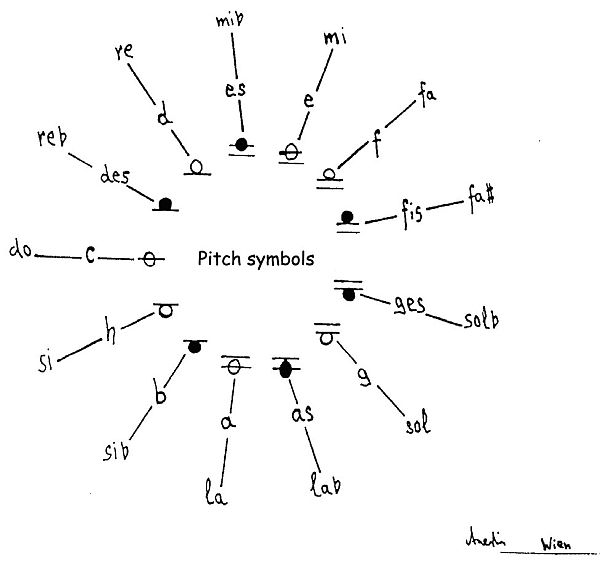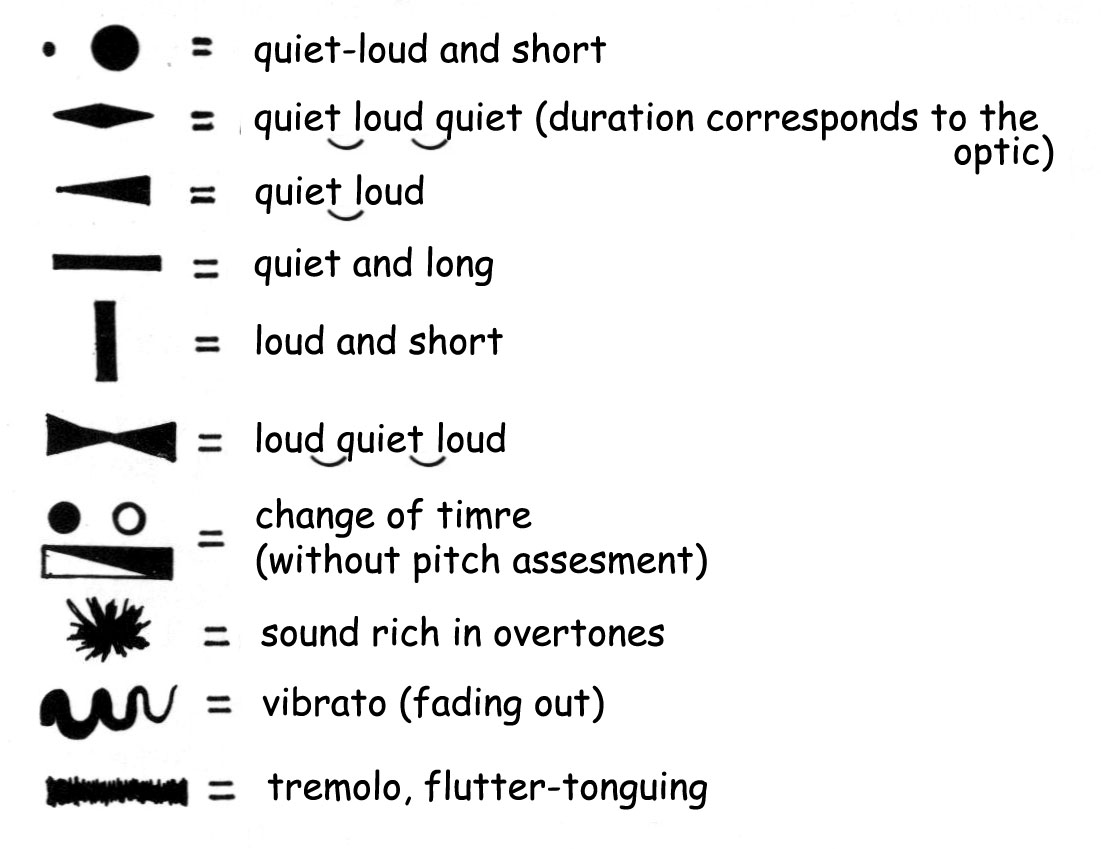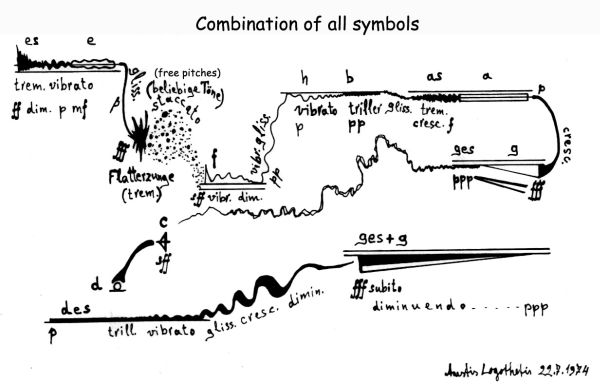THE POLYMORPHISM OF LOGOTHETIS' NOTATION
Logothetis's urge to start a new, different musical notation derived from the problems music was facing during his time. According to his words: In this way, the compass of modes of musical expression is significantly expanding. However, the notation with which one wants to describe the sonic events is not adequate for this purpose. Several problems arise out of this: not only noise-like sounds can only be represented with great effort or in some cases not at all, but the desire for a flowing music whose genesis can be experienced again and again is impossible to realize in this way(1). Considering therefore that the musical material was infused with new sonic possibilities, Logothetis tried to find a way to include into notation some additional parameters of sound, such as the time parameter of the musical structure, the positioning of sound in space, that graphic scores, independent of their function as notation, also have a meaning in the visual realm. The timber that can attain the quality of noise, and the homogenized flow of sound masses. Because of these additional parameters, this graphical notation system was more flexible and polymorphic than the traditional one. In addition, the composer tried in some way to protect on one hand the uniqueness of each performance and on the other hand the preservation of a piece's principles, giving the musicians designated flexibility (while performing). According to Logothetis: What fundamentally differentiates graphic notation from traditional notation is the afore mentioned polymorphism, which clearly enables all performers to retain their subjective reaction times. The composer takes into consideration the divergences of the different performers in composing and expects a certain degree of surprise through the new formalization of musical form in every performance.(2)
According to Logothetis the polymorphism of graphical notation has both to do with space and with the method by which it is read. Traditional notation is divided into systems and is read from left to right, like books. But since sound does not behave in the way written word does, we could think about using pictorial notation to represent musical events. (...)because musical time doesn't follow any direction, let alone the conventional left to right writing found in literary forms.(3) The duration, time in a musical piece, is associated with motion in space and determined by its placement within it. When a piece of paper is used as a space for representing sonic events, every point and line is brought into relationship with the entire surface and is temporally defined as short or long. This arbitrary correspondence between surface and symbols allows for the temporal associations of sonic events and the control of their duration; while out of convention, the positioning of musical events high or low on the paper represents high and low pitches respectively(4). During the development of his notation system in the 60s, Logothetis completed more than 100 graphical notations.
At this point we should explain the terms "graphical notation" and "musical graphic", that were coined in an attempt to define this new script in music. Notations are, generally, systems of signs/symbols, but the musical graphic is a painting, a drawing(5). The important difference between them is the fact that a graphic, though musical, conveys a meaning not because of its use of signs and symbols, but because of its special aesthetic quality(6), while notation is a code, related to semiotics. A graphical score is basically judged by the musicians, who comprehend, read and perform the music that lies beneath the script. In any case though, the dividing line between the two is blurry.
Concerning Logothetis's graphical scores, both terms have been used. Karkoschka for example classifies them in the "musical graphic" category. On the other hand, Logothetis himself referred to his system as a "graphical notation system", since his main focus was to broaden the musical script/code and not to provide a score with illustrative elements.
With this notation he tried to offer performers the possibility to enact music dynamically and unpredictably. That is why he developed three kinds of symbols in his notation system:
A. Pitch - symbols:

Fig. 1, Pitch - symbols
The first symbol type, seen in fig.1, consists of pitch - symbols for the realization of the tone-constellations, which can be played in every octave and combine with other markings.
B. Association - factors:

Fig. 2, Association - factors
The second category (fig.2) consists of association symbols and factors, which deal with loudness, timbre changes and sound character. The information resides in the shape of the symbol: dots mean short, and lines long note durations; loudness is derived by the size and intensity of the symbols; sound character and accent can be interpreted according to the sign's shape; the color of the signs indicates timbre changes.
C. Action signals

Fig. 3, Action signals
The third category (fig.3) consists of action symbols, which are lines and dots in movement. This graphical movement is to be transferred correspondingly to instruments (for transformation into music).
In the score these three kinds of symbols are combined, while the composer is trying to capture on paper his musical idea. Below there is a description example, given by Logothetis himself, of the symbols and their combinations.

Fig.4. a typical graphical score
The above example illustrates (fig.4) that, regardless of the symbols related to the dynamics and playing technique, the ledger line symbols coincide with specific notes - the pitch being defined by the performer - while symbols lacking ledger lines relate to noises with indefinite pitch. The quality and way of playing them is left to the performer's decision, so long as the noise's auditory outcome corresponds to the visual representation adopted by the composer. All these components will be brought into relation by means of a primarily acoustic setting and its permanent intrinsic visualization. The visual results will inform about the auditive events and their character. This kind of sound organization gives performers the freedom to participate in a multilayered hierarchy of sounds and actively shape the evolutionary polymorphy of the produced sonority7. This means that the composer himself defines the boundaries of the performer's liberty as an interpreter through the way in which he draws the pattern, or graphical notation.
You can hear an interpretation of the examle above.
__________________
1 Anestis Logothetis, Kurze Musikalische Spurenkunde. Eine Darstellung des Klanges, Melos, 1970, Bd. 2, p. 39-43
2 Anestis Logothetis, "Über die Darstellung des Klanges im Schriftbild", Impluse: für Spielmusikgruppen, Universal Edition, Wien, 1973, p. 3-9
3 Anestis Logothetis, "Über die Darstellung des Klanges im Schriftbild", Impluse: für Spielmusikgruppen, Universal Edition, Wien, 1973, p. 3-9
4 Anestis Logothetis, Zeichen als Aggregatzustand der Musik, Wien, 1974
5 Walter Gieseler, "Zur Semiotik graphischer Notation", In: Melos NZ, Bd. 4 (1978), p. 27-33
6 Walter Gieseler, "Zur Semiotik graphischer Notation", In: Melos NZ, Bd. 4 (1978), p. 27-33
M, Bavelli, A. Georgaki
